Posts in Category: ZimmVet News & Events
Flea and Tick Preventatives
Written by Valerie – ZimmVet CSR Lead

Have you ever wondered why your pets’ Veterinarian recommends administering flea and tick preventatives over winter?
There is a common misconception that if there is snow on the ground and temperatures are cooler that fleas and ticks are not out. While it is true that flea and tick activity may slow during the winter months, they are able to survive any time the temperature is above freezing, even during the winter months when it is snowy as long as they have a host such as an animal or person.
Ticks carry various diseases that have the potential of being very dangerous or even fatal for animals and humans. These diseases include but are not limited to Lyme disease, Anaplasmosis, Ehrlichiosis, Rocky Mountain Spotted Fever and Powassan virus disease. If these diseases are contracted and are undetected or remain untreated, they can have long-term adverse effects on the body.
Fleas are very active in the Fall months as temperatures begin to drop. Fleas survive by biting a host and taking a bloodmeal from them. Oftentimes they seek out our furry counterparts as a warm host to survive the fall months which can result on your pet bringing them into your home, where they can survive throughout the winter. It can be very difficult to clear your home of fleas once an infestation takes place as the lifecycle is very complex and they lay large amounts of eggs rapidly. The only way to rid your home of a flea infestation is by vacuuming daily, washing of blankets and bedding in hot water, brushing your pet and treating all fibrous surfaces while treating your pet and administering a preventative. It can take months before your home is free from these pesky biting parasites. Fleas can cause flea bite dermatitis in pets and people which is a reaction to the protein in the saliva from the flea bite and is extremely itchy.
It’s always easier to prevent rather than treat diseases.
Routine checkups: Why are they important?
By: Monica Bock veterinary technician in training at Zimmvet
What are routine checkups?
Routine checkups will consist of a yearly or bi-yearly physical and lab work. This is important, because often while technology has advanced, we may not catch a disease or parasite from the first sample taken. This can also aid in treatment of your pet if something is consistent within the routine checkups, it can be monitored and growth or progress of the issue can be tracked for better treatment. This would also be the time we vaccinate your pet from unwanted disease that could be potentially fatal to you or your pet.
What type of pets need them?
Routine checkups are recommended for all pets healthy in appearance or not! Many pets are good at hiding discomfort, pain or illness and this can make it difficult for even the pet parent to identify an issue with their pet. No matter how well you may know your pet, things can be missed and could potentially be detrimental to that pet’s wellbeing if treated too late. Routine checkups are even more essential when the pet is older, as with ageing comes illness and discomfort.
What your veterinarian is looking for in a physical:
Head, fingers, knees, and toes! Your doctor will check everything with a quick assessment of the pet’s outward appearance. Looking at your pet’s body condition score, ears, eyes, lymph node sizes, toes, knees/ joints, abdomen, throat, mouth and for any lumps and bumps on the body your doctor can get a better idea if more testing would be needed for a potential disease or ailment. If your pet is considered a senior, a doctor may also add eye pressure, eye testing or take more time talking about joint related diseases that tends to be common in older pets but not as common in younger pets.
Lab testing and bloodwork:
At both your annual and biannual exam bloodwork is generally done to ensure your pets health adding additional trend data that can be looked at to monitor progression of a disease or to ensure that your pet is continuously healthy. Depending if your pet is considered a senior, juvenile or young adult bloodwork may differ slightly. Depending on the age of the pet they can be more prone to ailments and disease thus need to be tested for different things.
Biannual vs annual checkups:
Its biannual checkup times! Many people question why they need to come back again for more lab work and a checkup as they did so earlier in the year. A biannual while important in itself is not the same as the annual exam, though similar procedures are performed. Biannual exams are meant to ensure that there is nothing new could have popped up since the beginning of the year and to record trends of upcoming or confirmed ailments due to the fact that pets age differently than humans.
Conclusion:
Keepin up with your pet’s health is important, a thorough examination of the pet can ensure your pets health and well-being. A yearly check up combined with your biannual can track trends and identify problems early on, proving increasing your pet’s quality of life. Even if you can’t see any signs of disease doesn’t mean that they are not sick or in pain this is why its important to schedule your routine examinations in a timely manner.
Why grooming your dog is important
Written by Valerie – ZimmVet CSR Lead
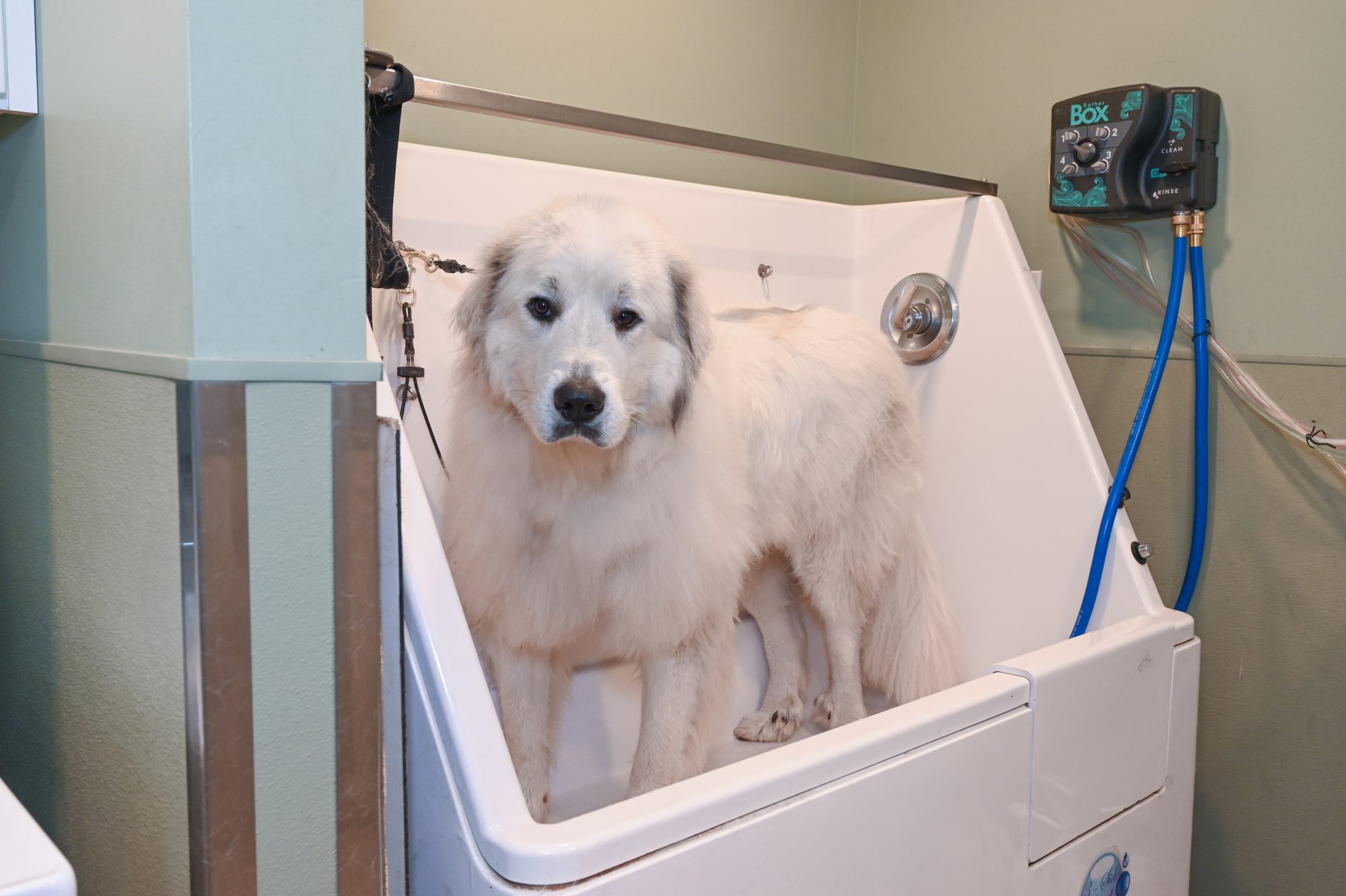
Grooming is vital to your dog’s health and well-being. The amount of grooming your dog needs will depend on their coat type, but adequate grooming is important for all dogs. Whether you take your dog to the groomer or tackle the task yourself, keep in mind the reasons why grooming is so important.
Nails – some dog’s will file their nails down as they walk on hard surfaces, but the nails should still be monitored to ensure that they are not getting too long as this can have adverse effects. If the nails are left to grow they can curl into the pad of the foot, get stuck as they are running and tear or break, or even cause mobility issues if your pet is experiencing discomfort when they walk; this may result in them compensating for the discomfort and changing their gait.
Skin and coat– the hair should be brushed regularly to avoid matting and to disperse the oils in the skin. Matting pulls on the skin and coat and is not only painful but often causes of sores. Regular brushing removes any dead hair to allow new healthy hair to grow in. Double coated dogs should be brushed with an undercoat rake to ensure that the dead hair in the undercoat is removed. Regular brushing will also decrease the amount of shedding from your pet. Always be sure to get your dog completely dry after bathing to minimize the risk of them developing hotspots.
Ears – ears should be cleaned regularly with an ear cleaner made specifically for pets. This will keep the ears clean of debris and wax that may build up and cause discomfort, odor or ear infections. Often times ear cleaners contain a drying agent that will dry any moisture in the ears that can cause an infection if left in the ear canal, it is especially important to clean the ears following, bathing, swimming or hunting.
The Sport of Skijoring
By: Dani Gunder VT at ZimmVet
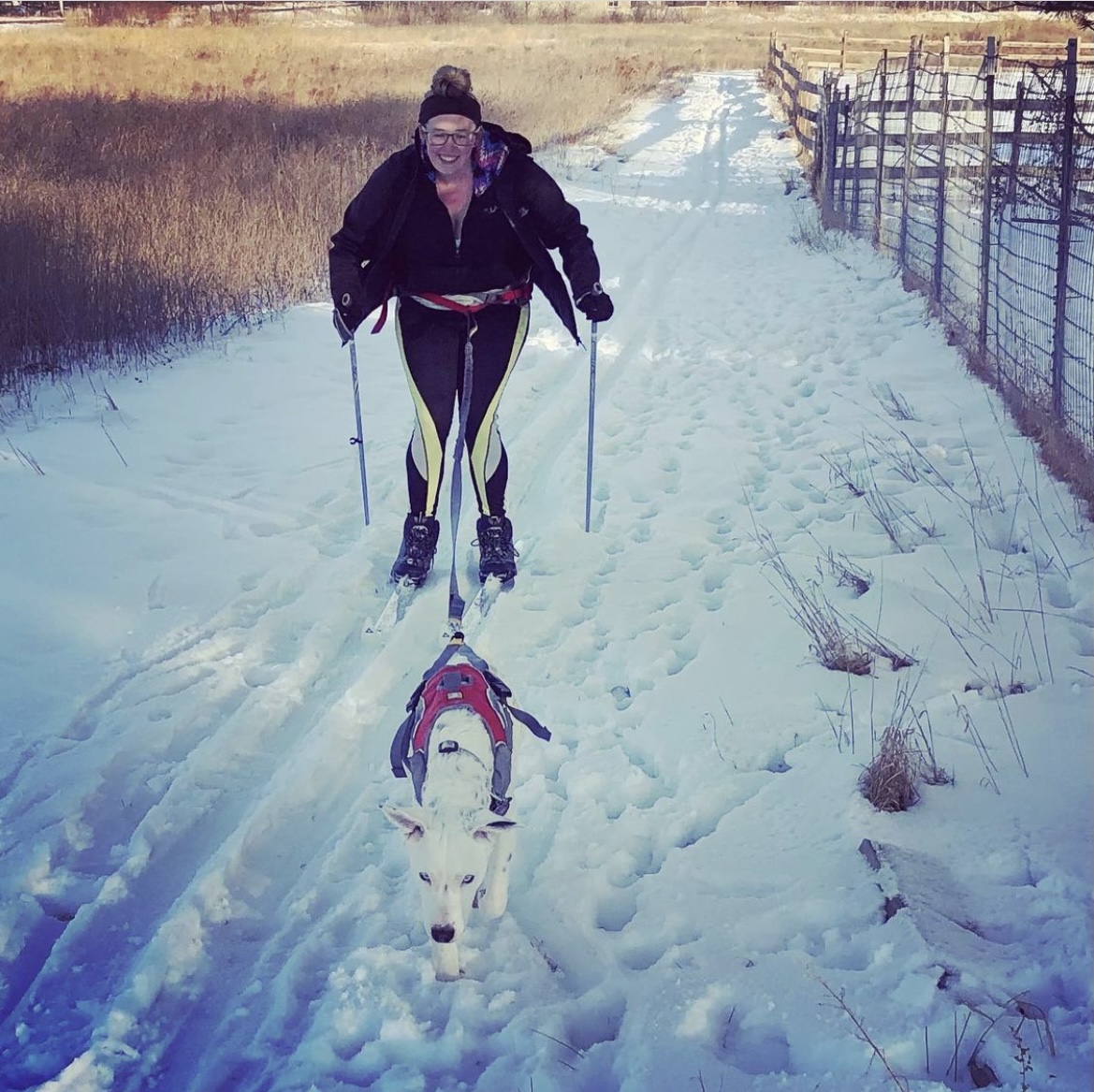
As many of us Minnesotans know, truly the best way to survive our cold winters is to find something enjoyable about them! Luckily there are plenty of winter sports for anyone and any interest- today we’d like to highlight skijoring; a winter activity that keeps us humans in shape and is such a positive way to exercise our dogs in winter! A positive way to look forward to our colder and darker months-
Skijoring is best described as a combination of dogsledding and cross country skiing; together we have a mushing event harnessed directly from dog to person and together cross wintery terrain for both hobby and competition.
The perfect skijoring dog can be any shape size or breed! And as people we can classic tour xc ski or skate ski for a quicker and more whole body workout! Some of the best skijoring partners enjoy working with their human, do not mind the winter elements, and can benefit from winter or consistent exercise. I’ve personally worked with aussies, mini aussies, and husky mixes in this sport and can honestly say size is not of biggest importance!
Ideally, we as the dogs’ leaders into this adventure are already confident and sure-footed on any type of cross country skis. And if not, we recommend hitting the trail without Fido for a bit. Once you are ready to help teach your 4-footed pal come back for the next session:
It’s important when introducing your dog to this sport that nothing we do is too much or too scary for them. Introduce equipment alone very slow and gradually, keeping things short and positive. When your dog has made some positive associations that our equipment itself is cool, then we can get strapped up and let them freely experience the sound/movements without being tied to us and ideally in a safe/secured fencing like backyard. Taking our time once your dog is fully used to equipment and skiing be sure they have a properly fitting and type of harness designed for pulling. Over time equipment will be no big deal and possibly our dogs are excited about. Many people cross train in warmer months with other omnijoring sports. Nothing wrong with some dogs needing more time and confidence.
Cue training will be important since as we ski our hands are full and we rely a lot on vocal commands. Familiarize your pup with “line out, gee, haw, easy, and woah” commands.
Next we can hit the trail! If you have the connection and ability, pairing your dog with an experienced skijoring dog will be very helpful. It’s even more easy for
Your first few outing to go out to groomed ski trails. Remember this all takes time and patience. Over time you and your canine compadre will be looking forward to snow and winters together to further advance your skills/technique and to explore all the amazing trails!
Happy skiing!
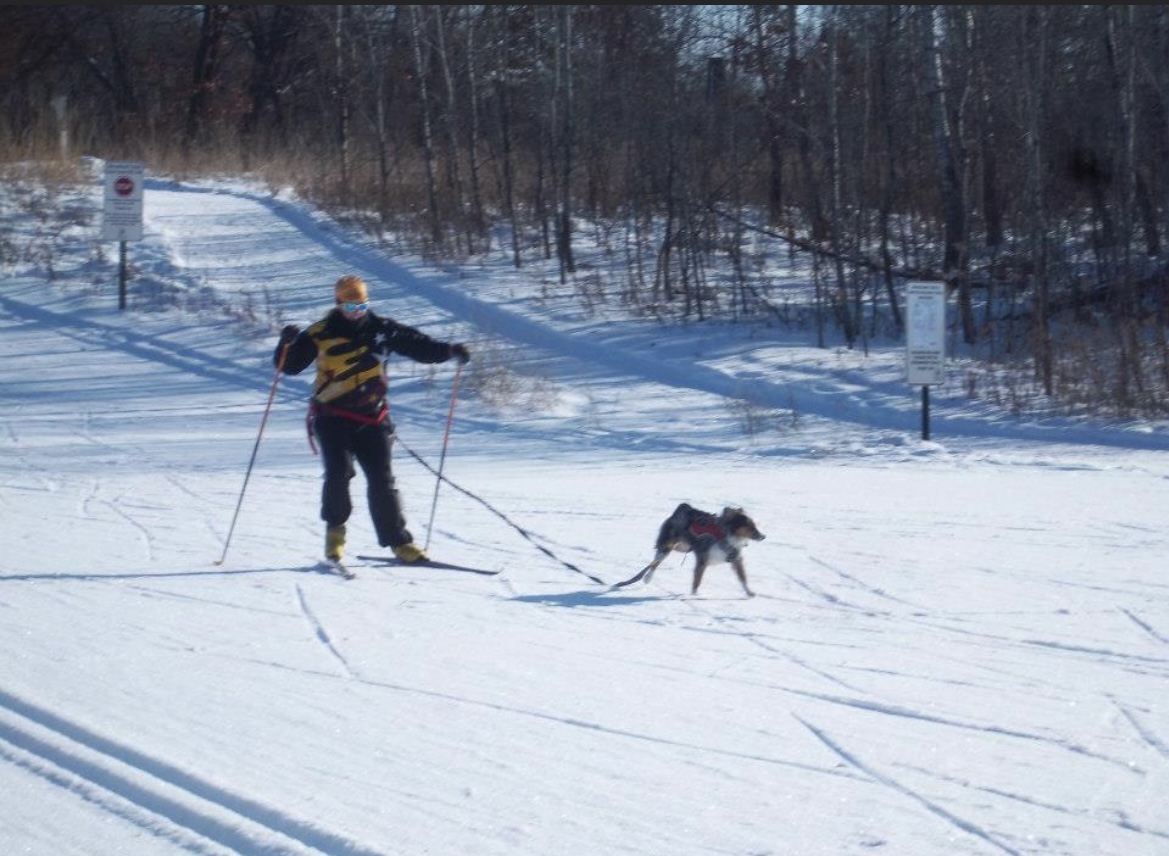
Beating the Winter Blues
Written by: Valerie Ferguson Customer Service Lead at ZimmVet
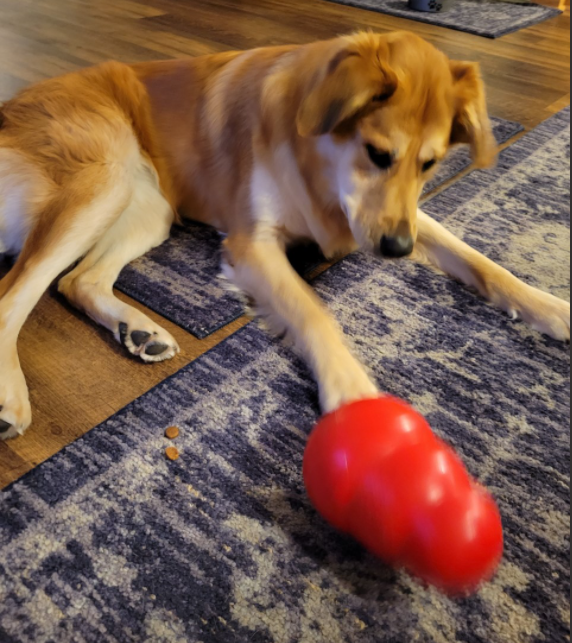
We all tend to go a little stir crazy when the weather is so cold that you can’t walk outside without your nose freezing, dogs are no exception. Long, cold winter days with minimal activity can cause your dog to be bored and may become destructive causing damage to your home or injury to themselves. Mental exercise has been proven to minimize behavioral issues. The goal of mental exercise is to engage your pet and exercise their brain. According to www.wagspgh.com – studies show that 15 minutes of mental exercise is equivalent to 60 minutes of physical exercise.
Some ideas for mental exercise include:
Puzzle toys
Setting up an obstacle course for your dog
Hide-and-seek – searching for treats
Stuffing a Kong with tasty treats (frozen)
Playing tug
Indoor fetch with a soft ball
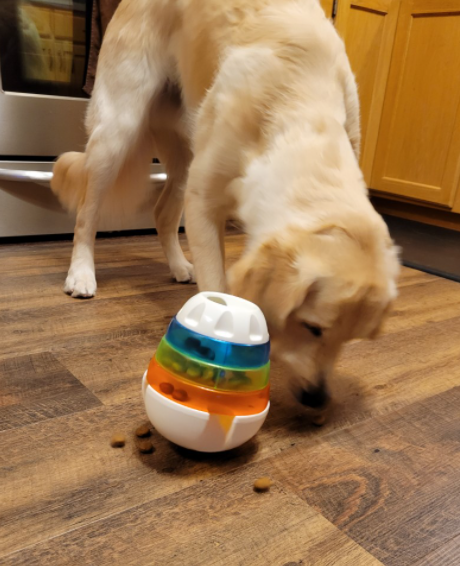
Shown above are a couple of photos of my dogs, Dakota and tucker, working for their dinner with a couple of their favorite puzzle toys.
Over the Counter Anxiety Supplements for Dogs
By: Dericka Haugan-Customer Service Rep at ZimmVet
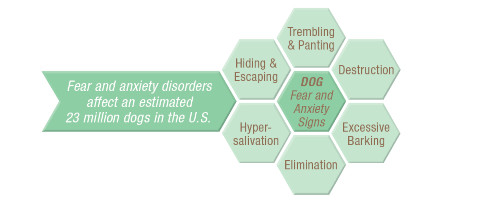
Do you notice your dog is showing signs of anxiety at home, daycare or when out and about with you? While you should always discuss options with your veterinarian there are some over the counter supplements you can try. You may have seen these for sale in your veterinary clinic but what are they and how do they work?
Solliquin
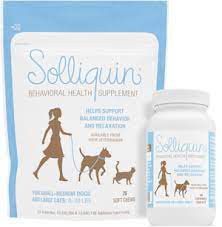
Solliquin is a behavioral health supplement that helps support balanced behavior and relaxation in dogs and cats. You can get Solliquin in a soft chew for dogs and cats between 8-30 pounds or in a capsule for dogs that are 8 pounds or more. Solliquin may take 30-45 days of consistent use to see results.
How does it work?
Solliquin contains a unique blend of amino acids, medicinal plants and protein.
- L-theanine: An amino acid found naturally in green tea. It directly stimulates the production of alpha brain waves, which create a state of deep relaxation, wakefulness, and mental awareness.
- Magnolia / Phellodendron: The combination of Magnolia and Phellodendron extracts appears to be synergistic, with the combination controlling stress and anxiety more effectively than either compound used alone.
- Whey Protein Concentrate: Contains NMXSLQ05®, a trademarked high quality protein source which supplements ten essential amino acids including the precursors of glutathione and serotonin.
This supplement is made to be used in combination with fear avoidance, behavioral modification and anxiolytics (supplements/pharmaceuticals). You can purchase Solliquin at select veterinary clinics or online, if purchased online make sure that you are purchasing through a reputable retailer as an over the counter you would not have to have a prescription to purchase. Purchasing through ZimmVet will give you a palatability guarantee so if your dog does not like them, you can return them to the clinic for a full refund.
Purina Pro Plan Calming Care
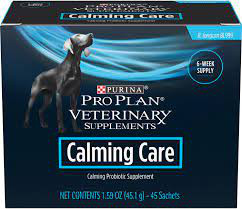
Purina Pro Plan Calming care is a calming probiotic supplement powder to be added to your dog’s food, it is also available for cats. It is recommended to help assist in the management of dogs exhibiting anxious behavior.
How does it work?
Proprietary use of probiotic strain BL999 to help dogs maintain calm behavior
Helps support dogs with anxious behaviors such as excessive vocalization, jumping, pacing and spinning
Helps dogs cope with external stressors like separation, unfamiliar visitors, novel sounds or changes in routine and location
Helps dogs maintain positive cardiac activity during stressful events
Promotes a positive emotional state and healthy immune system in dogs
Excellent palatability
Contains a probiotic with 1×10^9 CFU of Bifidobacterium longum BL999 per packet to support balanced behavior
At select veterinary clinics or online, if purchased online make sure that you are purchasing through a reputable retailer as an over the counter you would not have to have a prescription to purchase. Purchasing through ZimmVet will give you a palatability guarantee so if your dog does not like them, you can return them to the clinic for a full refund.
This supplement is made to be used in combination with fear avoidance, behavioral modification and anxiolytics (supplements/pharmaceuticals). You can purchase Purina Pro Plan Calming Care at select veterinary clinics or online, if purchased online make sure that you are purchasing through a reputable retailer as an over the counter you would not have to have a prescription to purchase. Purchasing through ZimmVet will give you a palatability guarantee so if your dog does not like them, you can return them to the clinic for a full refund.
Adaptil
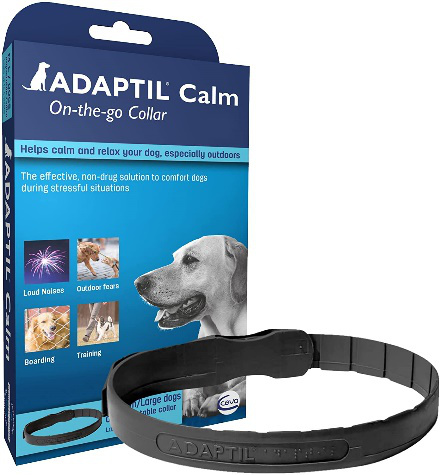
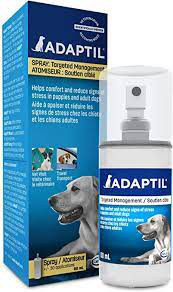
Not ready to use an ingestible supplement? Adaptil is an environmental tool that uses pheromones to help your dog feel calm and relaxed. Adaptil uses the natural pheromones similar to the ones their mothers used to give them natural comforting messages. This is also available for use in cats but be sure to get the correct species product as they do not work on the opposites.
How does it work?
Mother dogs communicate with their puppies through natural messages released into the air: “comforting messages “(called Pheromones). These odorless messages are only perceived by dogs. Cats and people are not affected. These “comforting messages” provide a strong signal of security and comfort to dogs of all ages. ADAPTIL Calm releases “comforting messages” to help dogs feel calm and relaxed at all times.
What not to do?
The collar is meant to be worn and should work for about 30 days, the collar should not be blocked by a harness, coat or regular collar. If it is repeatedly exposed to water, it may not work as long and should not be exposed to chlorine. The spray should not be sprayed directly on your dog and should be allowed to set for 10 minutes prior to letting your dog go into the area where they will be and should not be sprayed inside a carrier.
What is best for my dog?
There are so many options out there and the best way to decide what is best for your anxious pup is to discuss options with your veterinarian. It is best to try a supplement that will be able to be kept on the recommended schedule with each variety. You know your dog and should always advocate for their wellbeing. I hope this helps make discussing options with your veterinarian a little easier for you and helps make these products a little less confusing.
Anxiety in Dogs
By: Monica Bock, Assistant at ZimmVet
As pet owners we want our dogs to feel at ease and to always be happy and healthy! Sometimes depending on the pup and situation however, it can be difficult to manage their stress levels, which may or may not result in numerous behavioral issues. It is important to understand and be aware of issues such as peeing in the house, excessive panting, excessive drooling, chewing at their feet, over licking, etc. may not always be disease related behaviors. Please note however, if your pet is showing any of the listed issues discussed in this post, it is still recommended that the pet be seen by a veterinary professional first before determining if it is truly a stressed induced.
Common signs of stress in pets:
As stated by the AKC the following are common signs of stress and anxiety in pets:

- Aggression
- Urinating or defecating in the house
- Drooling
- Panting
- Destructive behavior
- Depression
- Excessive barking
- Pacing
- Restlessness
- Repetitive or compulsive behaviors
It is important to note that not all pets will deal with stress or anxiety in the same way, as a pet owner getting to know your pet better and dog body language is a key first steps to treating your pet’s overall anxiety.
Different types of stress:
As there is not just one thing that causes anxiety there is typically one of the three types that may cause your pet to exhibit any one of the previously listed signs of anxiety above. One being separation anxiety, fear/noise related anxiety and aging anxiety.
What is separation anxiety?
Separation Anxiety being very common in pets, is the anxiety in which the pet experiences stress when the owner is absent/ way from the pet. While there are different levels of Separation anxiety, it can sometime lead a pet to have some unruly behaviors while their owner is away. According to the RSPCA website, 9 out of 10 dogs experience separation anxiety and may exhibit behaviors such as excessive barking, eliminating in the house, self-harm, or may display more destructive behaviors such as chewing or scratching inappropriate objects.
What is Fear and noise Anxiety?
Your pet may experience fear from loud noises or become anxious at the vet or other new places! Just like human children new experiences and sounds can be scary; depending on how the pet associates the experience anxiety may follow shortly after possibly progressing or becoming worse through time. Some pets may try to escape or hide from the source of their anxiety and in some cases, medication may be needed to manage it.
What is Aging Anxiety?
As our pets age they are going through changes that may cause stress on their mental state. A pet that could like going to the vet may not like it anymore or a pet that loved kids may just want to be left alone and avoid them as they age. It is important to know as a pet ages they may become more painful and not be able to do the same things they once did, because of this they can become stressed and show signs early on.
How to avoid stress:
To keep your pet happy and behaviorally healthy there are ways to avoid anxiety early on in development or to prevent your pets stress and anxiety form worsening over time. If you want to avoid stress/ anxiety early on in puppies or older pups making sure you have basic knowledge of dog body language, specific breed needs and basic personality traits as well as providing proper socialization you too can sometimes avoid major anxiety in your pet
Treatment options:
So, your pet has anxiety, don’t worry all is not lost! After consulting with your Veterinarian, they will provide options based on their observations, that would best suit your pet for them and their type of anxiety. While patients with your pet can play a big part in aiding your pet’s anxiety, there are several things we can try on our journey to an emotionally healthy pet! Your veterinarian may suggest training with a behavioralist-whom is specialized in training pets with anxiety, Socialization, supplemental treatment (natural supplements), or prescribed medication to help your pet’s anxiety.
- Natural/Non-Medication treatment: A natural way to help your pet with anxiety would be training- specifically with a behavioral specialist. A trainer that specializes in anxiety or behaviorally unhealthy pets, will be able to help guide you and the pet
- Natural/Supplemental Treatment: “Natural supplements help dampen the overreaction of the brain” (Krenz 2022), providing the dog with a sense of calm. While one may not see an immediate result, each product has its own trial period in which the medication should be given at specified dosages for best effects. These supplements such as Solliquin, Rescue Remedy, Zylkene and more provide support for mild and moderate anxiety to help a pet strive to become more behaviorally healthy.
- Veterinary treatment-prescription medication: For pets with server anxiety sometimes a vet prescribed medication is needed! Sometimes pets have such anxiety about an event, place, noise, etc. That they need something a bit stronger or maybe even something to pair with one of the other above options. A doctor will evaluate the pet and determine if and what type of prescribed medication best suits your pet. If the pet displays such anxiety that it becomes dangerous, uncomfortable or harmful for you the owner, the pet themselves or others around the pet this may be the best option for you.
Thanksgiving safety tips for your pets
By: Amanda Jelinek, ZimmVet Receptionist
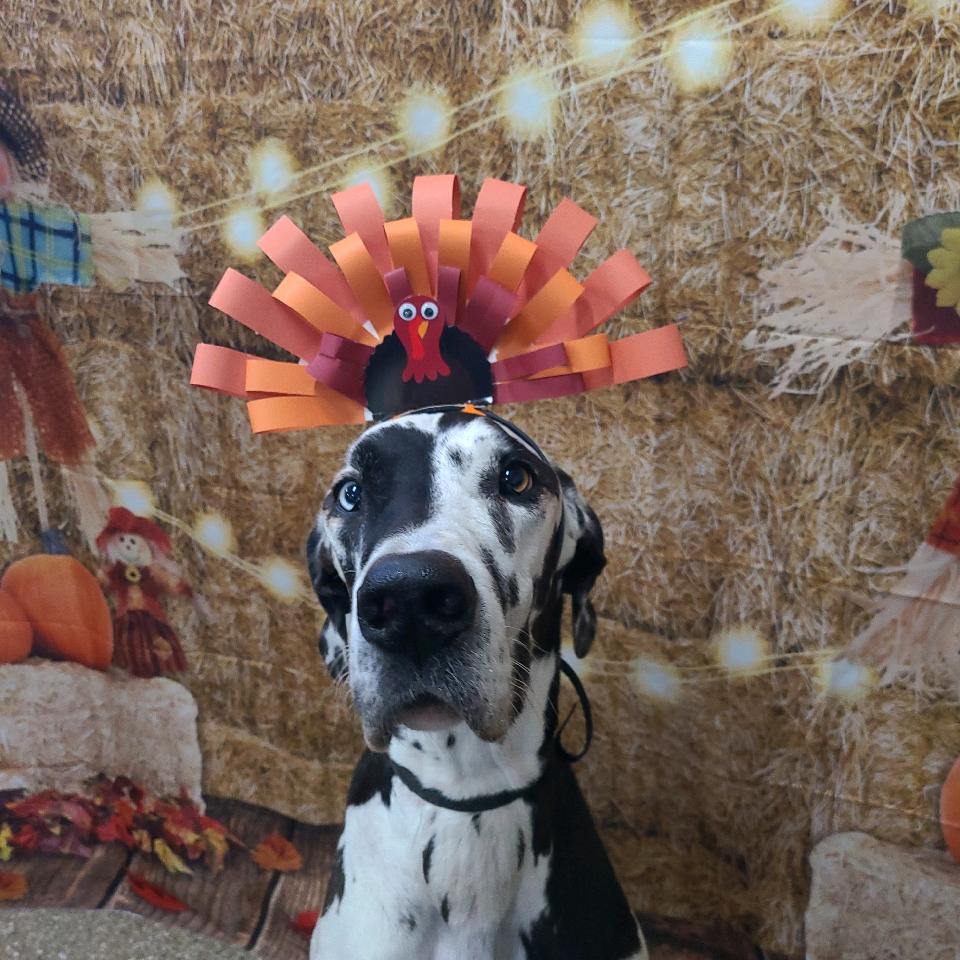
While people enjoy tasty foods during holiday gatherings, there may be hidden dangers in these foods if your pet indulges in them.
Greasy foods such as turkey skin or pork, even in small amounts, could be the cause of a very painful and possibly life-threatening condition known as pancreatitis.
All of those tasty additions to our favorite dishes, such as onions, garlic, bacon, raisins and grapes can cause gastrointestinal upset and even more serious issues such as organ damage or failure. Many candies, gums, whipped toppings and desserts can contain a sweetener called Xylitol which can cause hypoglycemia (low blood sugar), seizures, liver failure, or even death in dogs.
Bones can be dangerous to your pet’s digestive tract, and may splinter or become stuck causing an obstruction requiring surgery to retrieve the object obstructing the gastrointestinal tract.
If you feel that your pet would enjoy a special treat for the Holidays you can always splurge on a new bag of pet treats for them, or if you would like to share a tiny piece of white turkey meat, a tiny piece of unseasoned baked potato, a couple of unseasoned green beans or a few plain peas, please do. Always be mindful of the amount of vegetables your pet ingests as they may have adverse effects on the Gastrointestinal tract.
The ASPCA website offers a comprehensive listing of foods that are toxic for your pet.
Pet Food Grain Free Food Warning
By Dr. Maria Krenz, DVM
The U.S. Food and Drug Administration (FDA) has been investigating the link between grain-free diets and enlarged hearts (dilated cardiomyopathy) or heart disease in dogs and cats since 2018. Current research points to a reduced availability of taurine, an amino acid needed for heart function. Research also suggests Golden Retrievers may be genetically predisposed to taurine deficiency, making then at even higher risk when eating these diets.
Implicated Diets
Multiple diets have been implicated in the FDA’s findings. A June 2019 FDA report provides a list of pet food brands, which are grain-free. Almost 50% of the cases reported to the FDA were being fed Acana, Zignature or Taste-of-the-Wild brand diets. An additional, 13 other companies’ pet food diets were also listed.
FDA analysis of the diet composition in heart disease cases found that 91% were being fed a grain-free diet, and 93% had peas/lentils as the major grain substitute in the fed diet. Even if the food your pet is eating is not on the list, you should read the label. If your pet’s food is grain free or uses peas/lentils as a substitute for grain, you should consult your veterinarian right away and look at alternative diets.
Myth- Grains are a common Food Allergy
There is a myth that grains cause allergies, which is not supported by veterinary medicine. This is not the case. The reality is that true food allergies are extremely low in dogs and cats, and the offending substances are usually not grains. Grain allergies in dogs are so uncommon, in fact, they affect less than one percent of dogs. Pets are more likely to have an allergy to proteins like beef or chicken. If you feel like your pet has a food allergy or sensitivity, it is best to talk to your veterinarian about prescription diets formulated specifically for pets with food allergies.
Myth-Cats and Dog don’t eat Grains in the Wild
A common myth supporting grain-free foods is that cats and dogs in the wild do not eat grain. When an animal catches prey, it not only eats the muscle, but it also ingests the organ content. Many of the animals, which are prey of wild cats and dogs, do eat grain in their diet. When a cat or dog in the wild eat the organs of their prey, they are consuming small amounts of grain. If an animal only ate the meat of its prey, and not the organs with grain, it would develop nutritional deficiencies.
Common Grains
Until more research is available, ZimmVet does not recommend feeding a grain-free food. When looking at your pet food label to check if your food has grains, you might see a combination of some of the following: Wheat, Corn, Barley, Oats, Rye, Rice and Sorghum.
More information on the link between heart disease and grain free diets is available through FDA websites and multiple Veterinary University websites including University of California-Davis and Tufts University. Search “FDA grain free pet diet.” Please contact your veterinarian for medical advice with choosing your pet’s food.
Disclaimer: This written content is meant to be educational and is not medical advice. Always consult a veterinarian about medical advice for your pet.
Trick or Treating with Your Dog
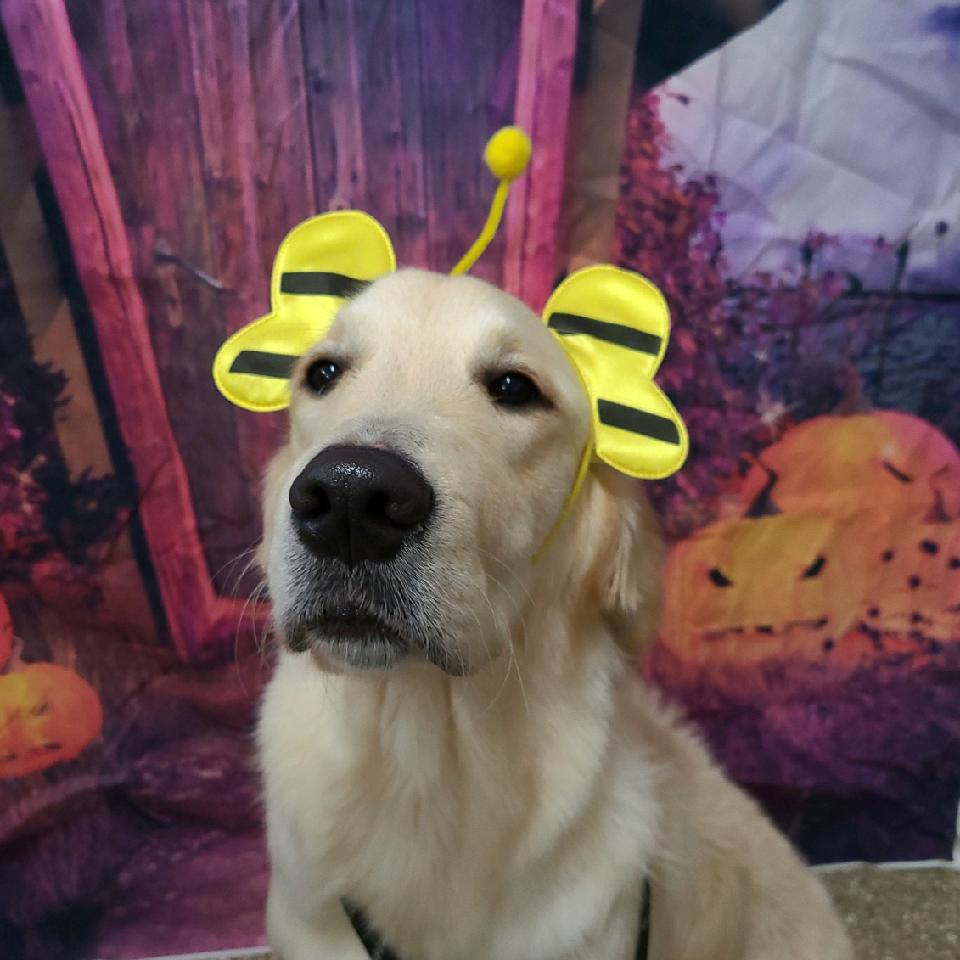
By Amanda Jelinek, Receptionist at ZimmVet
Halloween is such a fun time for you and your families; however, what about your furry family members?
Although we may think it would be great to have our dog with us while trick or treating, they may not think the same.
First, I would take some time and think of your dogs’ behaviors in different situations. Does your dog like ALL kids? Is your dog noise sensitive? Does your dog react to sudden movements or costumes? Does your dog do well on a leash? Does your dog startle easily in the dark? If you are unsure of any of these, it would be best to keep your dog safe at home in a quiet spot.
If your dog is a social butterfly and you think they will do great, do a ‘test run’ and see how they do prior to the big night. Be alert with your dog; make sure they do not eat any candy or anything off the ground. Remember that chocolate is toxic to them. If they ingest wrappers, toys, glow sticks etc. contact your veterinary office.
Some other things to be prepared for is to make sure your dog is visible; we recommend putting a reflective tag or leash on your dog. Depending how long you will be out, bringing water is a good idea. If you want to reward along the way, you should bring your dog’s favorite treats. Also, make sure you bring poop bags to pick up after your dog!
If you have any questions about bringing your dog out for this fun evening, reach out to your veterinary clinic staff.
Enjoy your evening and stay safe!!!


